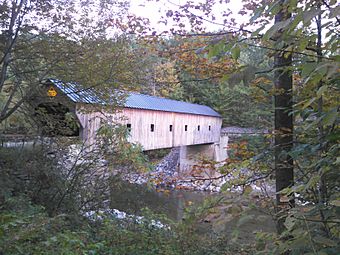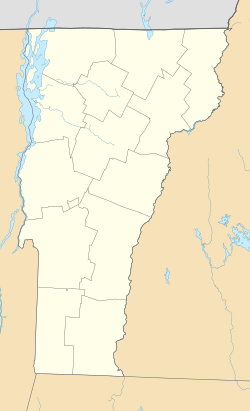Upper Falls Covered Bridge facts for kids
Quick facts for kids |
|
|
Upper Falls Covered Bridge
|
|
 |
|
| Location | Upper Falls Rd., S of VT 131 across the Black River, Weathersfield, Vermont |
|---|---|
| Area | 1 acre (0.40 ha) |
| Built | 1870 |
| Architectural style | Town lattice truss |
| NRHP reference No. | 73000215 |
| Added to NRHP | August 28, 1973 |
The Upper Falls Covered Bridge, also known as the Downers Covered Bridge, is a cool old bridge in Weathersfield, Vermont. It crosses the Black River and carries Upper Falls Road. This special bridge was built way back in 1840 and then rebuilt in 2008. It has a unique design called a Town lattice truss. You can spot it by its fancy ends, which look like old Greek buildings! In 1973, it was added to the National Register of Historic Places, which means it's an important historical spot.
About the Bridge
The Upper Falls Covered Bridge is found in a quiet, country part of western Weathersfield. It's just south of Vermont Route 131 on Upper Falls Road. This bridge has one main span, meaning it crosses the river in a single stretch.
How it's Built
The bridge rests on two supports called abutments. One is made of modern concrete, and the other is an old stone one that has been covered with concrete. The bridge is about 120 feet (37 m) long. It also has a roof that sticks out about 4 feet (1.2 m) at each end. The bridge is 18.5 feet (5.6 m) wide, but the road inside is about 15 feet (4.6 m) wide, so only one car can go through at a time.
The sides of the bridge are covered with vertical wooden boards. You'll notice square window holes cut into the sides, which let in some light. A metal roof protects the bridge from the weather.
Special Style
The ends of the bridge, called the portals, have a special look. They are covered with horizontal wooden boards and have a triangular shape with decorative molding. This style is called Greek Revival architecture. It was very popular when the bridge was first built.
Bridge History
This historic bridge was built in 1840 by a person named James Trasker from Claremont, New Hampshire. It's special because of its Greek Revival style, which is not common on other covered bridges in Vermont. Also, the old stone support (abutment) is still in really good shape, with stones laid together very carefully.
When the bridge was first listed on the National Register of Historic Places in 1973, it wasn't in the best condition. But don't worry! It got a full reconstruction in 2008, so it's now strong and ready for many more years.



